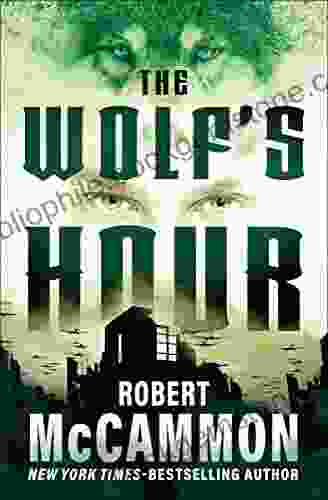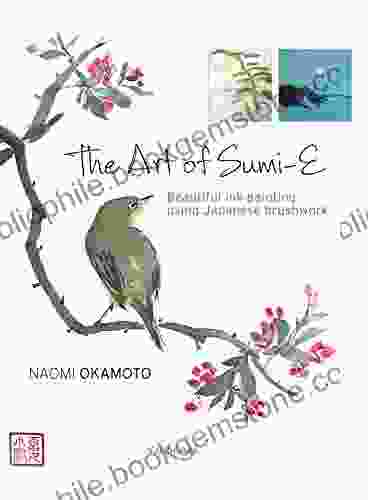The Allure of Ink Painting: A Journey into Japanese Brushwork and Artistic Expression

4.7 out of 5
| Language | : | English |
| File size | : | 204946 KB |
| Screen Reader | : | Supported |
| Print length | : | 160 pages |
In the tranquil realm of art, where inspiration flows like the gentle stroke of a brush, ink painting using Japanese brushwork holds a captivating allure. This ancient art form, deeply rooted in Zen philosophy and the profound connection between humanity and nature, invites us on a journey of artistic expression and spiritual discovery. Japanese ink painting, also known as Sumi-e, is a monochromatic art form that employs the transformative power of black ink to capture the essence of subjects ranging from serene landscapes to fleeting moments of everyday life. Through the skillful manipulation of brushstrokes and the delicate balance of light and shadow, artists strive to evoke emotions, convey narratives, and express the intangible aspects of their inner worlds. The origins of ink painting can be traced back to ancient China, where it flourished during the Tang dynasty (618-907 CE). During this period, Chinese artists developed a unique set of techniques and principles that laid the foundation for the development of Japanese ink painting centuries later. In the 13th century, Zen Buddhism was introduced to Japan, carrying with it a profound influence on the country's art and culture. Zen masters encouraged the practice of ink painting as a means of spiritual cultivation and artistic expression, emphasizing the importance of mindfulness, spontaneity, and the appreciation of the present moment. Throughout the centuries, Japanese ink painters have continued to refine and evolve their techniques, creating a rich and diverse body of work that captivates and inspires audiences worldwide. The fundamental materials used in ink painting are simple yet essential: ink, brush, and paper. The ink is typically made from a mixture of soot and water, creating a rich and deep black color that can be diluted with water to achieve varying tones and shades. The brush is a vital tool for creating the expressive brushstrokes that characterize this art form. Brushes come in a wide range of sizes and shapes, each designed to facilitate different techniques and effects. Japanese ink painting is traditionally executed on rice paper, which is known for its delicate texture and ability to absorb ink in a way that allows for subtle gradations and washes. The paper is often lightly sized with a layer of alum or glue to prevent the ink from spreading too quickly and to create a surface that allows for precise brushwork. The techniques employed in ink painting are as varied as the artists who practice it. Some of the most common techniques include: Japanese ink painting encompasses a wide range of subject matter, from the grandeur of nature to the intimate details of everyday life. Landscapes, flowers, birds, animals, and human figures are all common subjects in this art form. Beyond the literal representation of subjects, Japanese ink painting also often conveys deeper themes and emotions through its use of symbolism and metaphor. For example, bamboo is often used to symbolize resilience and strength, while cherry blossoms represent the ephemeral nature of life and beauty. Throughout the history of Japanese ink painting, numerous masters have emerged, each contributing to the development and refinement of the art form. Some of the most renowned masters include: These masters, along with countless others, have left an enduring legacy that continues to inspire contemporary artists around the world. In the present day, Japanese ink painting remains a vibrant and evolving art form. Contemporary artists continue to explore new techniques and subject matter, pushing the boundaries of the traditional medium. Ink painting is increasingly gaining popularity around the world, as more people discover its unique aesthetic qualities and therapeutic benefits. Workshops and classes in ink painting are becoming more widely available, allowing aspiring artists to learn from experienced masters and immerse themselves in the practice of this ancient art form. The allure of ink painting using Japanese brushwork lies in its ability to capture the essence of nature, evoke emotions, and express the inner world of the artist. Through the mindful application of brush and ink, artists create works that are both aesthetically pleasing and deeply resonant. Whether you are an experienced artist or simply curious about this ancient art form, I encourage you to explore the world of ink painting. In the meditative process of creating ink paintings, you may discover not only a new artistic skill but also a deeper connection to yourself and the world around you. History and Origins
Materials and Techniques
Subject Matter and Themes
Masters and Influences
Ink Painting Today
4.7 out of 5
| Language | : | English |
| File size | : | 204946 KB |
| Screen Reader | : | Supported |
| Print length | : | 160 pages |
Do you want to contribute by writing guest posts on this blog?
Please contact us and send us a resume of previous articles that you have written.
 Best Book
Best Book Page Flip
Page Flip Bookshelf
Bookshelf Literary loom
Literary loom Chapter
Chapter Bookish
Bookish PageTurner
PageTurner Bibliophile
Bibliophile Story
Story Inkwell
Inkwell Bookworm
Bookworm Labyrinth
Labyrinth Plot Twist
Plot Twist Prose
Prose Paperback
Paperback Storyteller
Storyteller Sanctuary
Sanctuary Fiction
Fiction Reading
Reading Chronicle
Chronicle Read
Read Rachel Schreiber
Rachel Schreiber Shane Lambert
Shane Lambert Gordon Mackenzie
Gordon Mackenzie Mike Ashley
Mike Ashley Debra Gwartney
Debra Gwartney Joseph L Scarpaci
Joseph L Scarpaci Robert Mccammon
Robert Mccammon Bianca Del Rio
Bianca Del Rio Jake Bible
Jake Bible Jayne Shrimpton
Jayne Shrimpton Mike Chaplin
Mike Chaplin Jennifer Criswell
Jennifer Criswell John L Williams
John L Williams Linda Holtzschue
Linda Holtzschue Kimora Lee Simmons
Kimora Lee Simmons Mona Golabek
Mona Golabek Jon Nelson
Jon Nelson Ginger Booth
Ginger Booth Yaakov Yanky Greenspan
Yaakov Yanky Greenspan Heather Murdock
Heather Murdock Gianni Simone
Gianni Simone Judith Pearson
Judith Pearson Shantanu Naidu
Shantanu Naidu Leslie J Sherrod
Leslie J Sherrod Fred Moten
Fred Moten William Walker Atkinson
William Walker Atkinson Mark C Taylor
Mark C Taylor Cathy Johnson
Cathy Johnson Blue Knight
Blue Knight Kurt Meissner
Kurt Meissner Gerald M Kilby
Gerald M Kilby Irmgard Weitlaner Johnson
Irmgard Weitlaner Johnson Jim Carpenter
Jim Carpenter Paul Theroux
Paul Theroux H Peter Alesso
H Peter Alesso Gb Tran
Gb Tran Dima Zales
Dima Zales Dean Koontz
Dean Koontz The Total Travel Guide Company
The Total Travel Guide Company Bella Blair
Bella Blair Nathan Mccall
Nathan Mccall Robert Shufflebotham
Robert Shufflebotham Lisa Harris
Lisa Harris Manny Serrato
Manny Serrato Dallas Shaw
Dallas Shaw Garner Simmons
Garner Simmons Jamie Davis
Jamie Davis Greg Simonds
Greg Simonds Robert Elms
Robert Elms Nancy J Morris
Nancy J Morris Bradford Bates
Bradford Bates Marita Golden
Marita Golden Jean Hugard
Jean Hugard David Schwartz
David Schwartz Gina Dejesus
Gina Dejesus David Sobotta
David Sobotta Margaret Coel
Margaret Coel David Carrier
David Carrier Michael Hulse
Michael Hulse S L Giger
S L Giger Octavia E Butler
Octavia E Butler Gavin Menzies
Gavin Menzies Sonya Curry
Sonya Curry Tu Ilape Vimahi
Tu Ilape Vimahi Indy Quillen
Indy Quillen Charles Gorham
Charles Gorham Scott Lunt
Scott Lunt Tom Clancy
Tom Clancy Marilyn Grant
Marilyn Grant John Wooley
John Wooley Kimberly Brooks
Kimberly Brooks Riley Sager
Riley Sager Anne Marie Paquet Deyris
Anne Marie Paquet Deyris M S Holm
M S Holm Jessica Pan
Jessica Pan Steven D Wolf
Steven D Wolf Bob Spitz
Bob Spitz Lou Schreiber
Lou Schreiber M K Eidem
M K Eidem J G Heck
J G Heck M D Cooper
M D Cooper Godfree Roberts
Godfree Roberts Helen Wilkie
Helen Wilkie Kerry Duncan
Kerry Duncan Jonathan Ned Katz
Jonathan Ned Katz Gail Thorell Schilling
Gail Thorell Schilling Brian Patton
Brian Patton Rich Polanco
Rich Polanco Patrick Lange
Patrick Lange Rick Partlow
Rick Partlow Vincent Lenihan
Vincent Lenihan Mimi Kwa
Mimi Kwa Marlene Blessing
Marlene Blessing John D Macdonald
John D Macdonald Susan Zwerman
Susan Zwerman Joseph Luzzi
Joseph Luzzi Lucius Shepard
Lucius Shepard Jean Pierre Sylvestre
Jean Pierre Sylvestre Glenn Alterman
Glenn Alterman General
General Gayle Rosengren
Gayle Rosengren Gennaro Contaldo
Gennaro Contaldo David Leddick
David Leddick Valerie David
Valerie David Morris Rossabi
Morris Rossabi Bill Bryson
Bill Bryson Heather Morgan
Heather Morgan Cap Daniels
Cap Daniels Tasha Oren
Tasha Oren Megan Wells
Megan Wells Hans Von Trotha
Hans Von Trotha Christopher Butler
Christopher Butler Roger Kimball
Roger Kimball Ray Daniels
Ray Daniels Rebekah J Kowal
Rebekah J Kowal Thomas Dublin
Thomas Dublin Keisha J
Keisha J Yingjin Zhang
Yingjin Zhang Robert Charles Wilson
Robert Charles Wilson Mary E Davis
Mary E Davis Kay Redfield Jamison
Kay Redfield Jamison Janwillem Vandewetering
Janwillem Vandewetering Gabrielle Union
Gabrielle Union Ross Anderson
Ross Anderson Karen Traviss
Karen Traviss John La Farge
John La Farge B V Larson
B V Larson Robert O Harder
Robert O Harder Monona Rossol
Monona Rossol Len Lawson
Len Lawson Rosanne Knorr
Rosanne Knorr Rough Guides
Rough Guides Sylvie Covey
Sylvie Covey Casey Watson
Casey Watson Heather D Ward
Heather D Ward George Kubler
George Kubler Rose Edin
Rose Edin H Beam Piper
H Beam Piper Victoria H Smith
Victoria H Smith Giuseppe Leonardi
Giuseppe Leonardi Tabakmann
Tabakmann Masakazu Ishikawa
Masakazu Ishikawa Jennifer J Baumgartner
Jennifer J Baumgartner Jean Claude Ellena
Jean Claude Ellena Sharon C Cooper
Sharon C Cooper Margaret Randall
Margaret Randall Diz White
Diz White Jonathan P Brazee
Jonathan P Brazee M Angela Sanders
M Angela Sanders Gill Barron
Gill Barron Sandra A Krasovec
Sandra A Krasovec Thomas R Lindlof
Thomas R Lindlof Harlan Hogan
Harlan Hogan Unique Journal
Unique Journal H G Wells
H G Wells Kayla Machine
Kayla Machine Hannes Rall
Hannes Rall Sallie Ketcham
Sallie Ketcham Maggie March
Maggie March Julien Gorbach
Julien Gorbach James O Barr
James O Barr Tung Nguyen
Tung Nguyen Sam Magavern
Sam Magavern Jeanine Kitchel
Jeanine Kitchel J B Turner
J B Turner Rachel Berenson Perry
Rachel Berenson Perry Laird Barron
Laird Barron Carolyn Phillips
Carolyn Phillips Mickey Zucker Reichert
Mickey Zucker Reichert Robert Hughes
Robert Hughes January Bell
January Bell Roger Housden
Roger Housden Gail Pallin
Gail Pallin Julien Blanc Gras
Julien Blanc Gras Clayton M Rines
Clayton M Rines Roland Betancourt
Roland Betancourt John Seed
John Seed Tiffany Jenkins
Tiffany Jenkins Theodora Goss
Theodora Goss Geoff Saunders
Geoff Saunders Hubert Allcock
Hubert Allcock Morr Meroz
Morr Meroz Harry Turtledove
Harry Turtledove Maksim Goldenshteyn
Maksim Goldenshteyn Candice Lau
Candice Lau Simone Edwards
Simone Edwards Logan Ryles
Logan Ryles Larry D Ellis
Larry D Ellis Jen Turano
Jen Turano P Z Walker
P Z Walker Nalo Hopkinson
Nalo Hopkinson Jenefer Robinson
Jenefer Robinson Rick Steves
Rick Steves Oleg Senkov
Oleg Senkov The Dancing Pages Publishing House
The Dancing Pages Publishing House Stanley C Jenkins
Stanley C Jenkins Rosie Rosenzweig
Rosie Rosenzweig Joseph Sheppard
Joseph Sheppard Luigi Lanzi
Luigi Lanzi Gail Morin
Gail Morin Lyn Barrett
Lyn Barrett Peter Canellos
Peter Canellos Helena Hunt
Helena Hunt Grace Lee Boggs
Grace Lee Boggs Marcel Proust
Marcel Proust Shari Lapena
Shari Lapena Steve Roberts
Steve Roberts Michael Oren Fitzgerald
Michael Oren Fitzgerald S L Rowland
S L Rowland Joanne Sharpe
Joanne Sharpe Hannah Hinchman
Hannah Hinchman Liz Scotta
Liz Scotta Nicole Falls
Nicole Falls Ryan Debruyn
Ryan Debruyn Timothy Ellis
Timothy Ellis Rachel Baker
Rachel Baker Iris Murdoch
Iris Murdoch Lucy Worsley
Lucy Worsley Meriel Thurstan
Meriel Thurstan Ian Coleman
Ian Coleman Harmon Cooper
Harmon Cooper Ian King
Ian King Kiyo Sato
Kiyo Sato Max Wilk
Max Wilk Theo Fennell
Theo Fennell Pam Flowers
Pam Flowers Gene Luen Yang
Gene Luen Yang Gregory Maguire
Gregory Maguire Linda Cooper Bowen
Linda Cooper Bowen Sahera Patel
Sahera Patel Greater Than A Tourist
Greater Than A Tourist Nick Middleton
Nick Middleton K Stephen Prince
K Stephen Prince Winston S Churchill
Winston S Churchill Wendy Hollender
Wendy Hollender Kim Brown Seely
Kim Brown Seely Jaquavis Coleman
Jaquavis Coleman Sara Ivy Hill
Sara Ivy Hill Joanie Holzer Schirm
Joanie Holzer Schirm Nathaniel Flakin
Nathaniel Flakin Kyle Chayka
Kyle Chayka Black Rose
Black Rose George R R Martin
George R R Martin Graham Rowley
Graham Rowley Joseph Heywood
Joseph Heywood Sam Kashner
Sam Kashner Liz Lerman
Liz Lerman Simon Tam
Simon Tam John Lewis
John Lewis Gerald Durrell
Gerald Durrell Margo Bond Collins
Margo Bond Collins Rachel Simon
Rachel Simon Jennifer D Walker
Jennifer D Walker James D Keyser
James D Keyser Rae Morris
Rae Morris Maxwell Farmer
Maxwell Farmer Robert Mads Anderson
Robert Mads Anderson William A Kappele
William A Kappele Renae Anderson
Renae Anderson Karen Taborn
Karen Taborn J Pal
J Pal Rochelle Alers
Rochelle Alers Jimmy Clay
Jimmy Clay Ilka Hammer
Ilka Hammer Gubba
Gubba Ruth Collis
Ruth Collis Paul Wallis
Paul Wallis Jen Finelli
Jen Finelli Sherman Alexie
Sherman Alexie Vine Aduara
Vine Aduara Catharine Slade Brooking
Catharine Slade Brooking Vasanth Simon
Vasanth Simon Carl Weber
Carl Weber Julius Schnorr Von Carolsfeld
Julius Schnorr Von Carolsfeld Ben Box
Ben Box J Susan Corley
J Susan Corley Kathleen James Chakraborty
Kathleen James Chakraborty Gordon Allard
Gordon Allard Harry Bernstein
Harry Bernstein Sandy Mitchell
Sandy Mitchell Shimon Redlich
Shimon Redlich K Kris Loomis
K Kris Loomis Dr Will Taegel
Dr Will Taegel Gary Greene
Gary Greene Orla Kiely
Orla Kiely Garance Dore
Garance Dore Pat Mcleod
Pat Mcleod Terry Harrison
Terry Harrison Global Baby Care
Global Baby Care Tom Wheeler
Tom Wheeler Jennifer Worth
Jennifer Worth Gabriella Guglielminotti Trivel
Gabriella Guglielminotti Trivel Tayari Jones
Tayari Jones Jakob Tanner
Jakob Tanner Gloria Fossi
Gloria Fossi Marie D Jones
Marie D Jones Vivienne Westwood
Vivienne Westwood Kal Wagenheim
Kal Wagenheim Heinz Peter Wagner
Heinz Peter Wagner Matt Hranek
Matt Hranek Thomas A Kelly
Thomas A Kelly Katie Dowe
Katie Dowe Reyna Grande
Reyna Grande Gil Mcneil
Gil Mcneil Jim Schutze
Jim Schutze Ian K Smith
Ian K Smith Justin Taylor
Justin Taylor Tad Williams
Tad Williams Remy Stern
Remy Stern Jonathan Moeller
Jonathan Moeller Gav Thorpe
Gav Thorpe Robin Landa
Robin Landa Cj Fentiman
Cj Fentiman Gary Troia
Gary Troia Kyle Kirrin
Kyle Kirrin Mark Anthony Rolo
Mark Anthony Rolo Yayoi Kusama
Yayoi Kusama George H Gisser
George H Gisser Mark Doty
Mark Doty Susie Nash
Susie Nash James Willard Schultz
James Willard Schultz James Fox
James Fox Colin Thubron
Colin Thubron Ellen Tomaszewski
Ellen Tomaszewski Grif Stockley
Grif Stockley Tom Coffman
Tom Coffman Paul Wells
Paul Wells Jim Gertz
Jim Gertz Rebecca Atwood
Rebecca Atwood Kyle Mills
Kyle Mills Merri Melde
Merri Melde Ben Philippe
Ben Philippe Hannu Rajaniemi
Hannu Rajaniemi Paul Benedict Rowan
Paul Benedict Rowan Jay Roeder
Jay Roeder Ted Seth Jacobs
Ted Seth Jacobs Paris Permenter
Paris Permenter Pat Spooner
Pat Spooner Peter Hopkirk
Peter Hopkirk Ta Nehisi Coates
Ta Nehisi Coates Laura Boswell
Laura Boswell James Lawson
James Lawson Lawrence Grobel
Lawrence Grobel Stephen Malins
Stephen Malins Ian Olio
Ian Olio Philip Steadman
Philip Steadman Jonathan Brooks
Jonathan Brooks Karin Slaughter
Karin Slaughter Harriet Beecher Stowe
Harriet Beecher Stowe William Mcinnes
William Mcinnes Sarah Cortez
Sarah Cortez Susan Hardman Moore
Susan Hardman Moore Spike Bucklow
Spike Bucklow Greg Montego
Greg Montego Donna Rifkind
Donna Rifkind Nikki Mcclure
Nikki Mcclure Nathan Johnson
Nathan Johnson Lucy Grealy
Lucy Grealy Sam Gennawey
Sam Gennawey Neema Avashia
Neema Avashia Tyler Farnham
Tyler Farnham Ja Nese Dixon
Ja Nese Dixon Paul Oldfield
Paul Oldfield Thomas Lockwood
Thomas Lockwood Jan V White
Jan V White Greg Albert
Greg Albert David Brin
David Brin Helen Birch
Helen Birch M G Herron
M G Herron Mark Harlan
Mark Harlan Guisela Latorre
Guisela Latorre Judy Cook
Judy Cook Gregg Kreutz
Gregg Kreutz R L Giddings
R L Giddings Henry Bond
Henry Bond Patrick Leigh Fermor
Patrick Leigh Fermor Skye Mackinnon
Skye Mackinnon Richard Dunlop
Richard Dunlop Yaa Gyasi
Yaa Gyasi Leo Tolstoy
Leo Tolstoy Steven Watts
Steven Watts Haidee Jo Summers
Haidee Jo Summers Brenda Cooper
Brenda Cooper Jeanne Cooper
Jeanne Cooper Justin Mccurry
Justin Mccurry Nick Webb
Nick Webb Henry Warren
Henry Warren David Rapp
David Rapp Oscar Wilde
Oscar Wilde Steve Cohen
Steve Cohen Peter F Hamilton
Peter F Hamilton Joyce Maynard
Joyce Maynard Harold Speed
Harold Speed Jonathan Nevair
Jonathan Nevair Robert Asprin
Robert Asprin Mariah Carey
Mariah Carey Helen Hoang
Helen Hoang Thomas Wolf
Thomas Wolf John Muir Laws
John Muir Laws Lingo Mastery
Lingo Mastery Sandra Stewart
Sandra Stewart Sarah Sofia Granborg
Sarah Sofia Granborg George Mather
George Mather Richard Poulin
Richard Poulin Sebastian Smee
Sebastian Smee Aubrey Beardsley
Aubrey Beardsley Stephen Fraser
Stephen Fraser Roxanne Dunbar Ortiz
Roxanne Dunbar Ortiz J A Rogers
J A Rogers Gunnar Staalesen
Gunnar Staalesen Kristal Norton
Kristal Norton Hooman Majd
Hooman Majd Nichole Ashlyn Jackson
Nichole Ashlyn Jackson Helen Cates
Helen Cates Jerry Yarnell
Jerry Yarnell Sujatha Gidla
Sujatha Gidla Viola Grace
Viola Grace Ndeye Labadens
Ndeye Labadens Will Jordan
Will Jordan Joi Barrios
Joi Barrios Judy Batalion
Judy Batalion Olivia Gaines
Olivia Gaines Tobie S Stein
Tobie S Stein Jonquil Graham
Jonquil Graham Gary W Gallagher
Gary W Gallagher Kimberly A Whitler
Kimberly A Whitler Luke Sullivan
Luke Sullivan Robert Sinnerbrink
Robert Sinnerbrink Saxon Andrew
Saxon Andrew Tetsuko Kuroyanagi
Tetsuko Kuroyanagi Guillermo Del Toro
Guillermo Del Toro Hal Rubenstein
Hal Rubenstein Marla Day Fitzwater
Marla Day Fitzwater Piper Kerman
Piper Kerman Victoria Abbott Riccardi
Victoria Abbott Riccardi Jonathan Chapman
Jonathan Chapman Werner Stejskal
Werner Stejskal Isadora Duncan
Isadora Duncan Larry Schroeder
Larry Schroeder Kim Heinbuch
Kim Heinbuch Mike Shepherd
Mike Shepherd Megan Fairchild
Megan Fairchild Heidi Ardizzone
Heidi Ardizzone H Robert Charles
H Robert Charles George W Bush
George W Bush Judy Tzu Chun Wu
Judy Tzu Chun Wu Mark Evanier
Mark Evanier Heidi Moksnes
Heidi Moksnes Doug Gelbert
Doug Gelbert Gayle Bird
Gayle Bird Susan Donnell
Susan Donnell Steve Lyons
Steve Lyons Shameek Speight
Shameek Speight Helen Burstyn
Helen Burstyn Justine Cowan
Justine Cowan Kit Thornton
Kit Thornton Gilbert King
Gilbert King N Scott Momaday
N Scott Momaday Eden Robinson
Eden Robinson Sonora Carver
Sonora Carver Billy Pegram
Billy Pegram Dana Tenzler
Dana Tenzler Syd Field
Syd Field Michael Z Williamson
Michael Z Williamson Robert Farris Thompson
Robert Farris Thompson Mark Bergin
Mark Bergin Jonathan D Spence
Jonathan D Spence Erin H Turner
Erin H Turner Grey King
Grey King Kimberla Lawson Roby
Kimberla Lawson Roby Richard Sayette
Richard Sayette Warren Olson
Warren Olson Vic Costello
Vic Costello Rinoz
Rinoz Scott Ryan
Scott Ryan Vanja Hamzic
Vanja Hamzic Christopher R Cox
Christopher R Cox Grant Fuller
Grant Fuller Tracy Kidder
Tracy Kidder Ginger Lawrence
Ginger Lawrence Harry Feeney
Harry Feeney Jan Strickland
Jan Strickland Gerald Sorin
Gerald Sorin W Michael Gear
W Michael Gear Naomi Duguid
Naomi Duguid Lee Summers
Lee Summers Jack Higgins
Jack Higgins Gordon Doherty
Gordon Doherty Jeremy Hicks
Jeremy Hicks Michael Cawood
Michael Cawood Katharine Gregorio
Katharine Gregorio Polly Mckenna Cress
Polly Mckenna Cress Simon Proudman
Simon Proudman Polly Barton
Polly Barton Tilda Balsley
Tilda Balsley Zondervan
Zondervan Keith Brymer Jones
Keith Brymer Jones Michael J Arlen
Michael J Arlen Malcolm C Salaman
Malcolm C Salaman Naima Coster
Naima Coster Viktorija Todorovska
Viktorija Todorovska Helena Reckitt
Helena Reckitt Peter Matthiessen
Peter Matthiessen Joe Jackson
Joe Jackson Geoffrey Corfield
Geoffrey Corfield Billy Showell
Billy Showell Leigh Bardugo
Leigh Bardugo Jerry Shepard
Jerry Shepard Stephanie Storey
Stephanie Storey Jay A Stout
Jay A Stout Wolfgang Riebe
Wolfgang Riebe Gianrico Carofiglio
Gianrico Carofiglio Giannalberto Bendazzi
Giannalberto Bendazzi Bradford Pearson
Bradford Pearson Lizzy Bequin
Lizzy Bequin Tom Kidd
Tom Kidd Sarah Helm
Sarah Helm Lisa Strattin
Lisa Strattin William Boyd
William Boyd Johnny B Truant
Johnny B Truant Simu Liu
Simu Liu John Canemaker
John Canemaker Glen Gavin
Glen Gavin Jen Carter
Jen Carter Henry Hongmin Kim
Henry Hongmin Kim William C Rempel
William C Rempel Sunil Tanna
Sunil Tanna Sydney L Iaukea
Sydney L Iaukea Jean Claude Baker
Jean Claude Baker Toni Petniunas
Toni Petniunas Neil Gaiman
Neil Gaiman Robert Kunstaetter
Robert Kunstaetter Tw Robinson
Tw Robinson Lucy Coleman
Lucy Coleman Joanne Fluke
Joanne Fluke Tawana
Tawana Michael Shea
Michael Shea David Ogilvy
David Ogilvy John Barnes
John Barnes Paul Levitz
Paul Levitz Roger Winter
Roger Winter Joseph Labrecque
Joseph Labrecque Rebecca Zanetti
Rebecca Zanetti Ivan Margolius
Ivan Margolius Greg Iles
Greg Iles Lisa Dines
Lisa Dines Sara El Sayed
Sara El Sayed Jonathon Keats
Jonathon Keats Zane Grey
Zane Grey Andreas Marks
Andreas Marks Randolph Lalonde
Randolph Lalonde E Train Learning
E Train Learning Jan Steinbright
Jan Steinbright Lisa Mulcahy
Lisa Mulcahy J Malcolm Garcia
J Malcolm Garcia Jonathan White
Jonathan White Judi Whitton
Judi Whitton Martina Nohl
Martina Nohl
Light bulbAdvertise smarter! Our strategic ad space ensures maximum exposure. Reserve your spot today!

 George HayesVibrant Italian Recipes Celebrating The Lemon: A Culinary Exploration With...
George HayesVibrant Italian Recipes Celebrating The Lemon: A Culinary Exploration With...
 Jeff FosterThe Ultimate Guide to Painting 83 Textures: From Grass to Glass to Tree Bark...
Jeff FosterThe Ultimate Guide to Painting 83 Textures: From Grass to Glass to Tree Bark...
 Herman MitchellThe Sentience Wars Origins: Lyssa Dreams of Hard Science Fiction, AI, and...
Herman MitchellThe Sentience Wars Origins: Lyssa Dreams of Hard Science Fiction, AI, and... Caleb CarterFollow ·5.2k
Caleb CarterFollow ·5.2k Edwin CoxFollow ·10.2k
Edwin CoxFollow ·10.2k Devin CoxFollow ·13.9k
Devin CoxFollow ·13.9k Cole PowellFollow ·17k
Cole PowellFollow ·17k Paul ReedFollow ·6.6k
Paul ReedFollow ·6.6k Bret MitchellFollow ·11.4k
Bret MitchellFollow ·11.4k Craig BlairFollow ·11.9k
Craig BlairFollow ·11.9k Harry HayesFollow ·15.2k
Harry HayesFollow ·15.2k

 Scott Parker
Scott ParkerIn Her Own Words, In Their Own Words: A Journey of...
In Her Own Words, In...

 Colin Richardson
Colin RichardsonYou Don't Have to Say You Love Me: A Lyrical Journey...
In the annals of popular music,...

 Clark Campbell
Clark CampbellThe Enthralling Narrative of John Tanner, the Falcon: A...
The Man, the...

 Glenn Hayes
Glenn HayesThe Wolf Hour: A Spine-Tingling Thriller that Unravels...
Synopsis Prepare...

 Thomas Mann
Thomas MannThe Pirate Tribulation: A Literary Masterpiece Exploring...
Setting Sail into the...

 Eugene Powell
Eugene PowellEscape The Rat Race And Live Life As An Expat
How to find a job abroad If you're...
4.7 out of 5
| Language | : | English |
| File size | : | 204946 KB |
| Screen Reader | : | Supported |
| Print length | : | 160 pages |





